Last Updated on August 26, 2025

Estimated reading time: 9 minutes
By Jim Ferri
Many travelers to Portugal set their sights only on Lisbon, the Algarve, and Porto’s wine country. That’s unfortunate, since they miss things to do in Coimbra, which is a surprisingly worthwhile — and easy — side trip from both Lisbon and Porto.
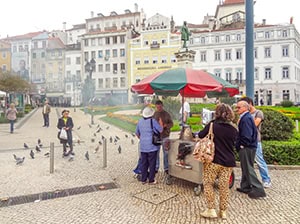
A beautiful small city that’s home to the oldest university in Portugal, it lures travelers with its beauty, history, and collegial atmosphere. Another plus is that it’s also less than two hours by train from Lisbon, about half that long from Porto. It’s well worth at least a two-day visit.
I was smitten with the city and felt its embrace soon after my arrival. As I was strolling about the broad tiled pedestrian streets in the historic center, I heard the sound of singing. Letting my ears lead me along for a long block or two, I came upon several female students from the University of Coimbra serenading passersby.
Many in the small audience showed their appreciation by dropping a euro or two onto the cape spread on the cobbles at the young woman’s feet. Others rushing on their way home did the same.
That wonderful, unexpected alfresco performance was a magical moment. For me, it was also a moment that showed the Portuguese respect and support for education.

Old Coimbra, Where There’s Many Things to Do
I had arrived by train from Lisbon early in the day. At the station, I took a taxi to the excellent Quinta das Lágrimas Hotel, one of Portugal’s historic hotels.
One of the reasons I selected the historic hotel was its beautiful gardens. It was in those gardens in the 14th century where Dona Inês de Castro, posthumously crowned Queen of Portugal, had her dalliances. It’s also where she was murdered.
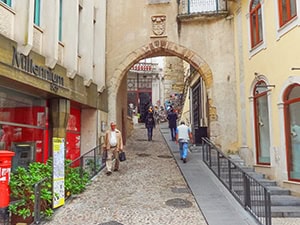
The gardens are an amalgam of several beautiful areas – including romantic, Japanese, medieval, a garden of scents, etc. They are also home to 20 species of birds. I could have spent a few hours wandering through them, but since I only had two days in Coimbra, I left the gardens after only a half-hour and headed over the river to the old town. It was a 20-minute walk, plenty of time to admire the beautiful old city spread that ran along its banks.
Missing the Bus
Wanting to make the most of my time, I went straight to the local tourist office. I asked about the yellow hop-on hop-off bus I had seen on the way from the station. It was right across the little square next to the office and would leave in two minutes, I was assured. Then, as I ran out the door, I watched as it pull away ahead of schedule.
In retrospect, however, the missed bus was also fortuitous since it gave me time to discover a charming city area. In fact, after only about 20 minutes, I found myself thinking about what a great little town Coimbra was turning out to be, a miniature “best of” Lisbon, all in one relatively compact area.
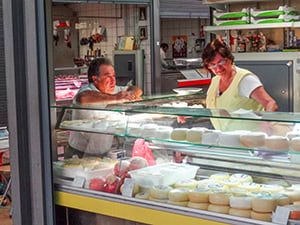
I also soon discovered a myriad of cafés and pastry shops. They were all bustling with locals savoring their morning coffee, much like in Lisbon. The tiled streets, although reminiscent of Lisbon’s grand avenues, were devoid of the usual tourist crowds. Large old-style street lamps adorned the buildings, adding to the enchanting atmosphere.
I continued strolling up several little cobbled lanes, absorbing the color and culture of the neighborhood about me. I was fascinated by local life all around me… a locksmith making keys in his little store, which was across from a dress shop, that was adjacent to a hair salon, which was next to a little café restaurant. Laundry hung above the street, shopkeepers chatted with shoppers, and waiters were reading their lunch-time tables. There was also, of course, that wonderful alfresco performance.
I felt I was in another century.
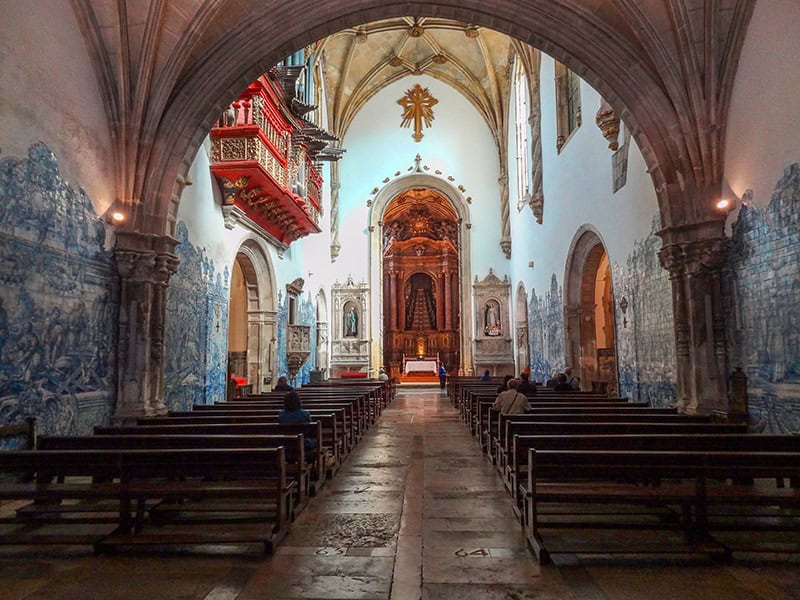
Santa Cruz Monastery
Continuing around the city, I later visited Santa Cruz Monastery, a national monument and the resting place of two of Portugal’s early kings. Inside, I found a beautiful church with walls covered with blue tiles and worshipers in ancient pews.
In the square in front of the church, Praca 8 de Maio, a dancing fountain contrasted with the solemnity inside. Walking down the adjacent Rua da Moeda, I was smitten by the medieval alleyways about two passersby-wide. Again, I quickly became lost in its warren of little lanes embracing every type of shop imaginable.

Convent of Santa Clara
That afternoon, I crossed back over the river and walked up the hill to the Convent of Santa Clara.
Like the crowning of Dona Inês de Castro, the convent is another of Portugal’s anomalies. After its last nun died in 1886, the law allowed the government to take over the convent. It soon converted it into an Army barracks.

After many years, however, the Army moved out, and the church and government are trying to sell the convent. In the meantime, it remains the final resting place of Portuguese Queen St. Isabel, who founded the convent and dedicated her life to the underprivileged.
The convent’s tiny church, with an altar and huge wall panels covered with gold leaves, is beautiful. Behind massive iron gates in its rear is Isabel’s ancient sarcophagus, with a life-size statue of the saint on top. Every year on July 8, Isabel’s feast day, 10 local men carry the statue around the city.
The curator in the museum shop explained that Isabel’s hand is a sacred relic, which can be viewed by the public. It was intact, he told me, but added it could only be viewed in years marked by some significant event. The last viewing took place on the 400th anniversary of the year her body was moved from the coffin in the rear of the church to its current place above the altar.
The tiny church is beautiful, with an altar and huge wall panels covered with gold leaves. Behind two huge iron gates in its rear is Isabel’s old sarcophagus, which has a life-size statue of the saint on top. Every year on July 8, Isabel’s feast day, 10 local men carry the statue about the city.
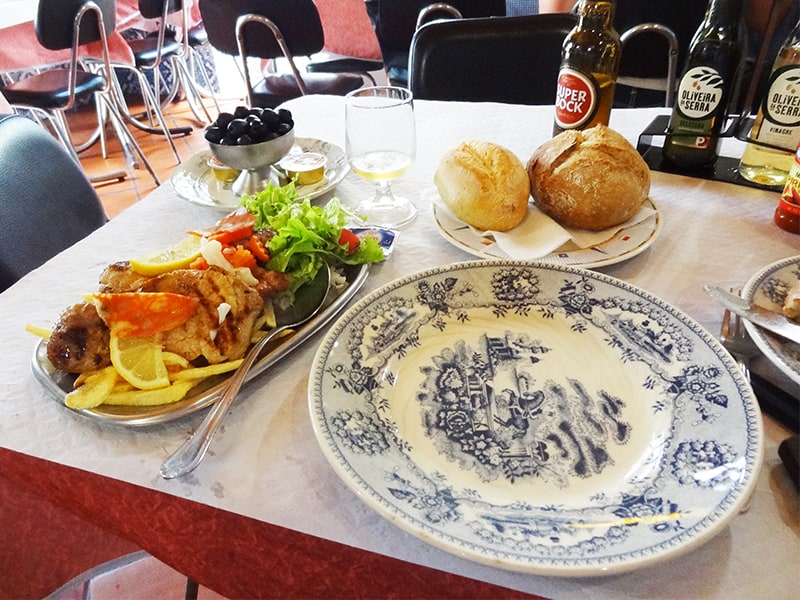
A Good Thing to Do in Coimbra: Find a Little Taverna
After leaving the convent, I began walking back towards the old city. I soon passed a small taverna, one of a multitude you find throughout the city. But here the owner stood outside, motioning for me to enter his small restaurant as another couple exited. Since I had been considering having a late lunch, I stepped inside. I found myself in a cozy little place, barely 15 x 15 feet in size, with just 10 or so tables and blue-tiled walls.
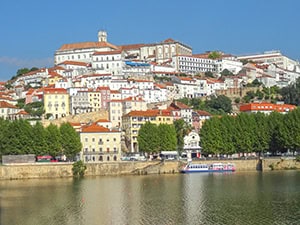
The menu mainly offered fish and pork. I decided to order cutlets with rice and chips. But since the menu had been translated into several languages, I wondered whether I would get what was described. After a brief conversation in broken English, he brought the meat out for me to look at, which turned out to be thinly sliced pork cutlets on the bone. The meal, a beer, and extra French fries the owner later brought to my table totaled only €10, less than I’d pay elsewhere in Europe.
While walking back to the Quinta das Lágrimas later, I couldn’t help but think the meal was a welcome surprise, like many other things I found in this atmospheric city. And I found myself wishing I could stay an additional day.
But there was that flight to catch in Lisbon…
You may also enjoy: The 10 Best Places to See in Portugal / Top 10 Things to Do in Lisbon (Plus 3 More) / 26 Great European Day Trips by Rail / Bus
If You Go:
Visit Portugal
http://www.visitportugal.com/en
Quinta das Lágrimas Hotel
Rua António Augusto Gonçalves
3041-901 Coimbra, Portugal
Tel: +351 239 802 380
http://www.quintadaslagrimas.pt/
Rail Europe
http://www.raileurope.com
Tel: (888) 438-RAIL (7245)

Love this!!! We are planning a trip to Lisbon….